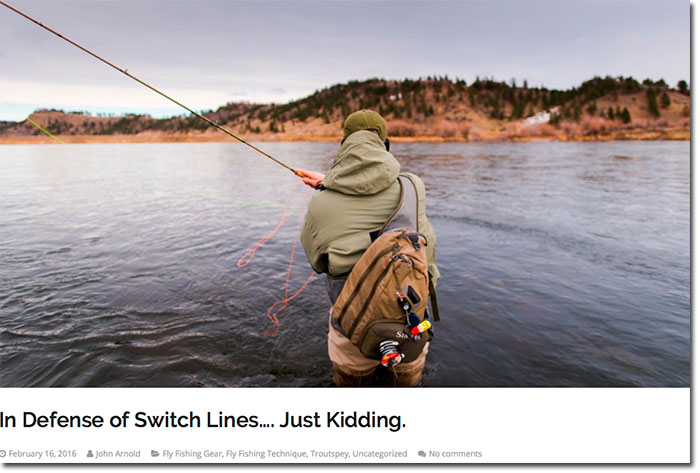
John Arnold at Headhunters has knocked one out of the park with a recent post – In Defense of Switch Lines….Just Kidding.
Not one to mince words or blush at the thought of pissing someone off with a comment (a most-often virtuous trait we find sadly lacking in the discourse of the day), John lays it out with practical, detailed advice on gear. Well played.
Lately I’ve seen a resurgence in the dreaded “switch” line. Particularly on newer spey rigs purchased in the Regionally. At our last clinic there were no less than 3 new outfits present rigged with switch lines. All were recommended as part of a rod/reel/line kit from where they were purchased. All 3 left the clinic optimized for spey casting with standard Skagit or Scandi shooting heads, and happier owners.
I’ve been bashing switch lines for years, and thought I had gotten in front of the disease. Apparently it has emerged as a new strain that is more resistant to my opinion. Or maybe just more folks are buying their spey gear in the Northern Rockies, where it’s less likely you’ll run into a knowledgeable spey technician, than in, say, Portland or Seattle.
While I’ll admit that in the last 2 years I have finally seen some useable switch lines, they still represent such a huge compromise that there is no way I can recommend them, nor have I ever met an experienced caster who prefers them over Spey lines. Or even uses them.
So let’s back up quickly, and review what these lines are designed for…
The term “switch” was first applied to rods short and light enough to be used as a single hander, and long enough to be used for spey casting. Remember that at the time a 13? #7 spey rod was considered small, so the jump down to 11 feet was drastic. The problem was that no lines existed that would perform spey casts on these new rods. And if they did, you certainly could have used those lines on your single handed 9? 5 weight to spey cast. So really, these were just shorter spey rods, and it baffles me why they didn’t refer to them as that. By building “switch rods”, however, manufacturers unwittingly sped up the trend towards shorter and lighter two-handed rods. In fact we’ve now reached the point where the difference in length between a “switch” rod and a “spey” rod is measured in inches, not feet.
Instead of designing much needed short-head spey lines for this new category of rods, manufacturers decided to match the new lines to the term, instead of the rod and the customers demand. Also, some of the rods were “overhead” 6 weights, and some were “spey” 6 weights. So we ended up with a bunch of switch rods and switch lines that had no consistency in length, taper, or grains across the industry. Nobody had a clue how to design a line that could perform powerful spey casts and act as a traditional overhead fly line. Because it can’t really be done. More on that later…
Read the rest of the post at the link above.

